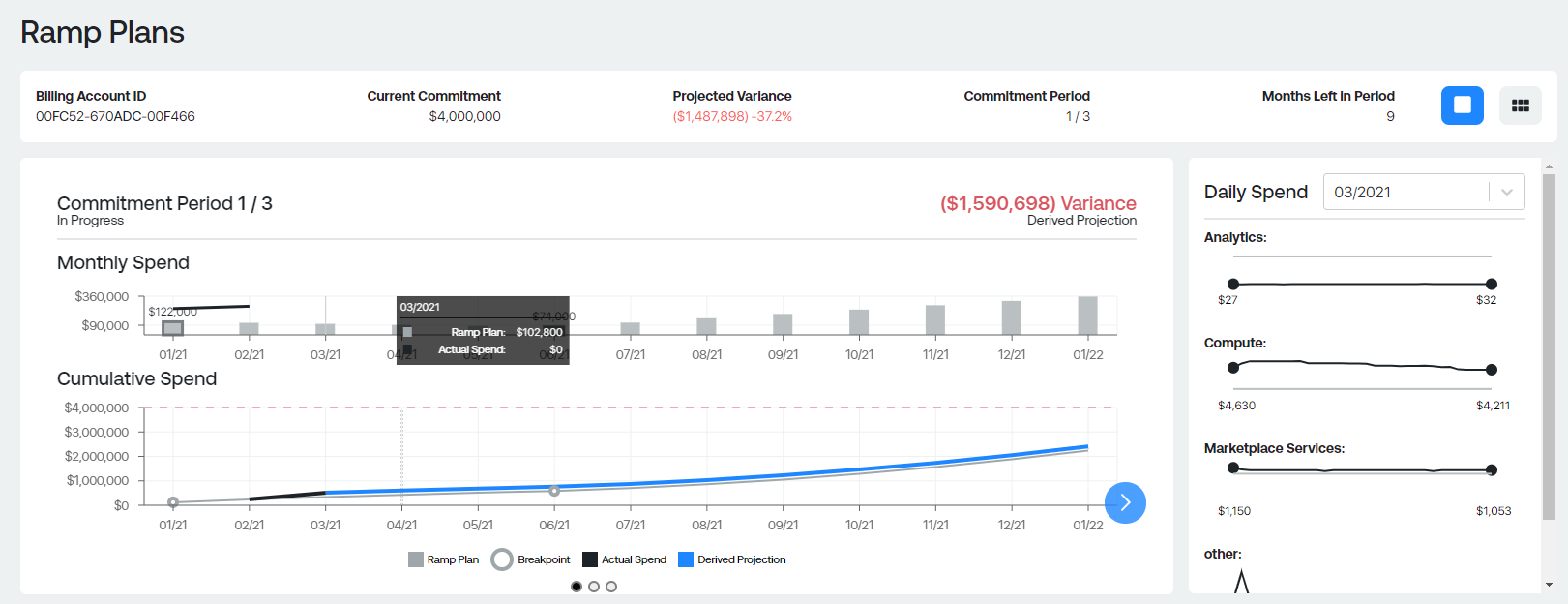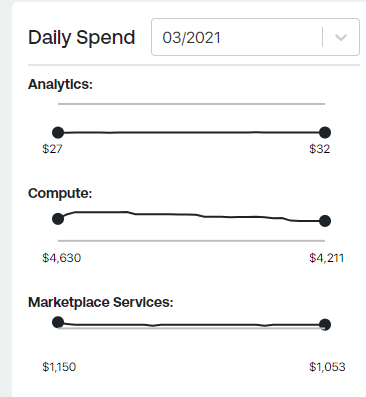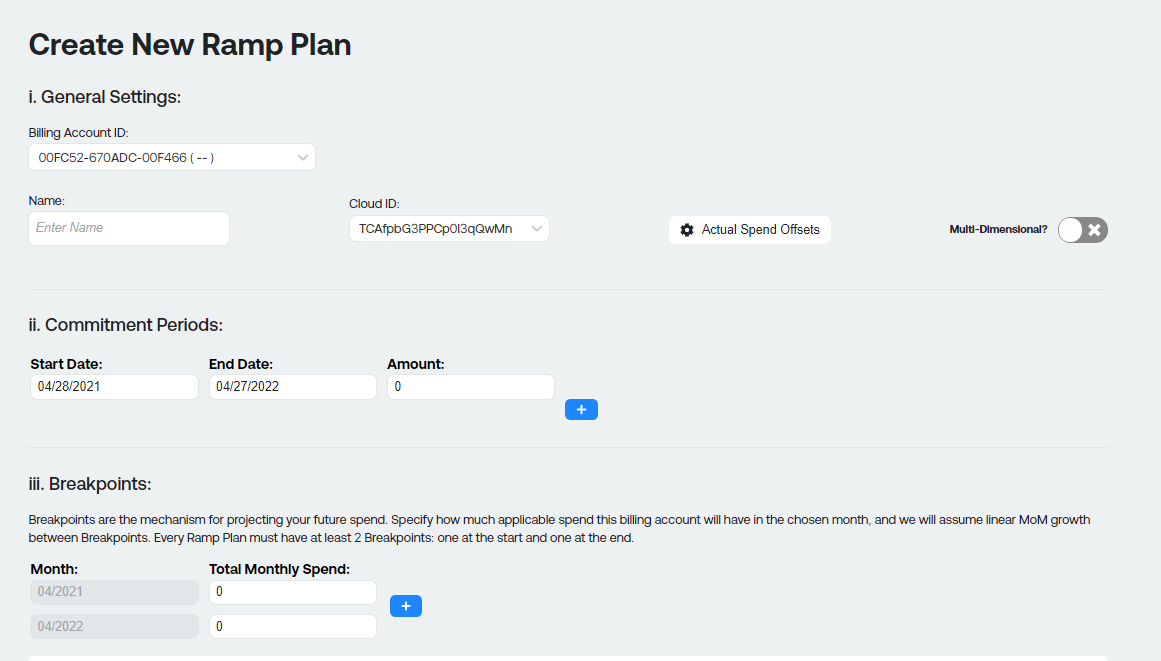Ramp Plans
Manage Contractual Commits with Ternary Ramp Plans
Overview
We know that as organizations make the decision to migrate to the cloud, they often sign multi-year deals that obligate a minimum level of spend. The issue is that often organizations want to know what a ‘safe-level’ of commit is before signing the contract, and post-commit want to know how much risk there is around not meeting their contractual obligation given their current run-rate.
With our Ramp Plans feature you can:
- Manage multi-year contracts to see how you’re tracking against your commit
- See what run-rate you need to achieve your commit
- Factor in the impact of discounts on your commitment amount
- Create multiple scenarios that factor in differing ramp assumptions
- Build a bottoms up Ramp Plan by Service or Product, allowing you to revise your assumptions on which service areas are over/under spending.
- Pre-contract signing, build out scenarios to gauge what is a safe level to commit to.
- See the impact of actuals on your ability to reach your commit
There are two distinct features for managing Ramp Plans. The first has to do with visibility while the other allows you to create Ramp Plans.
Ramp Plan Visibility
The initial pane when you click into Ramp Plans gives you high level information about your commit:
- What Billing Account ID is associated with the Commit
- Your commitment for the specific period.
- Based on current spend trends and your own projections how far off you are from meeting your commit.
Note: Because Ramp Plans are often tracked to ensure you meet the min. level of spend that's contractually obligated, the variance number in red indicates that you are at risk of NOT meeting your commit and thus are underspending, - What commitment period you are in. There are often multiple commit gates, that is customers will sign multi year deals that require a certain threshold of spend IN THAT COMMIT PERIOD.
- Months left in current commit period. This is intended to give you a sense of how much time you have left to make changes to your infrastructure to make sure you meet your commit.

Graphs Views
There are two graph views with the intent of giving you a monthly spend trend while allowing you to see your cumulative and what that implies for your contractual obligation,
Monthly Graph

The monthly graph gives you the ability to visualize how your actual spend is tracking against your budgeted Ramp Plan.
The grey bar represents your Ramp Plan projection i.e when you were creating your Ramp Plan what you thought you were going to spend.
The black line represents your actual spend. If the black line is ABOVE the grey bar that is a quick indication that in that particular month your actual spend outpaced your projection.
You can also hover your cursor over the graph to see what the actual amounts are for that month both for actuals and your Ramp Plans.
Cumulative Spend Graph
The cumulative graph gives you a quick visualization of whether or not you're on track to meet your commit.
There following pieces of information are on this graph:
- Ramp Plan: This is the projections you built yourself in the 'Create Ramp Plan' mode
- Actual Spend: This is what you actually spend upto the current period.
- Derived Projection: This line charts adjusts your spend based on the actuals. That is, it translates the graph downwards or upwards based on what you actually spend in prior month. For the future months. it assumes that you will spend the same as what you budgeted in your Ramp Plan.
- Breakpoints: (Description of breakpoints is given below in the Create Ramp Plans section)
- Commitment Line: This red dotted line represented the total amount you must spend for your commit.

Daily Spend Trends
If you've budgeted on a more granular level like categories for instance, the daily spend is quick way to visualize which areas of spend are trending higher than what you had projected.
The grey line is derived from taking your Ramp Plan monthly projection and diving it by the number of days in the month - hence it is flat.
The black line either above or below the line is what you actually spend that day.
If the black line is ABOVE the grey line as a whole, then that is an indication that you are OVERSPENDING in that specific category. If it's under the grey line, then the opposite holds true.
Another useful piece of information that can be gleamed from this section is to give you a sense of any anomalous spend. For example, you notice that your spend fluctuated in one month and has now come back down. By looking at the daily trend you could identify which category is originating that spend If you notice a big spike in the black line.

List of Ramp Plans
In the bottom section there's a list of all the Ramp Plans you have created with high level statistics on est. variance, and information about the commitment.

Ramp Plan Creation
From the visibility page you can create a new ramp plan by simply clicking on this button:

Once you click the above button, you will be directed to this page:

To create a Ramp Plan, follow these steps:
Step 1: Name your Ramp Plan Scenario
This is a way you to name whichever Ramp Plan scenario you are creating for easy reference when you want to choose it from your list.
Step 2: Pick the start and end dates of each of your commitment periods.
Contracts often have arbitrary start and end dates as well multiple commit period. Here you want to specify the start and end dates, and the value of EACH Commit period. For instance if you have the following contract details:
Commit Period 1:
01/01/2021 - 12/31/2021 for $5M
Commit Period 2:
01/01/2022 - 06/30/2023 for $8M
Commit Period 3:
07/01/2023 - 12/31/2023 $6M
In this case you would consider each commit period separately and enter it accordingly. In the above example, you should not aggregate your 3 year contract from January 1st 2021 to the end of 2023 as one commitment and aggregate the contract amounts.
Step 3: Start Modeling by Picking a Breakpoint.
To understand how to model your Ramp Plans, it's instructive to know the concept of Break points, the primary way in which we facilitate modeling within Ternary.
What is a breakpoint?
In order to simplify the modeling process, we use something called breakpoints. You should think of breakpoints as events in your model where you expect an increase or decrease in spend from your current spend.
For example, let's say in the start of the year as you begin migration, you are only spending $5,000 per month. But you expect that in month 6 you will have scaled your spend significantly to a $100,000 per month. Instead of having to specify how you will scale to a 100K on a month by month basis and having to input values for each month, you can simply pick two points in time and set those as your breakpoints.
Breakpoint 1 (starting in Month 1): $5,000
Breakpoint 2 (Starting in Month 6): $100,000
Our system will model the remaining months for you and assume linear growth across those months.
For any Ramp Plan you need at least two breakpoints, one at the beginning of your commit and one at the end. Thereafter you can add as many breakpoints as you see fit where you anticipate an increase in spend.
Step 4 (Optional): Set up manual offsets.
Often times your enterprise will spend money with google that counts towards your contractual commit but does show up in the billing export. Or it could be the case that there are discounts that you receive from your reseller off your bill which counts against your commitment.
To accommodate those scenarios, you can set up both recurring and one time offsets which then get incorporated in your timeline.
This allows you to get a more holistic view of the actual risk associated with meeting your contractual obligations.
Step 5 (Optional) : Make your projections multi-dimensional
You also have the ability to breakdown your budget by service. For instance if you are migrating from another cloud or moving from an on-premises solution you might have a sense of what you will spend on compute, storage, analytics etc. If you have a sense of what your budget is for each of those categories you can associate a budget amount with that category. If those categories don't encapsulate your entire spend, you can budget everything else into an other category.
This multi-dimensional budget will then show up as categories in the visibility page where you can track the daily spend trend of each category and see if you are over/under against what you had budgeted.
Updated 6 months ago
